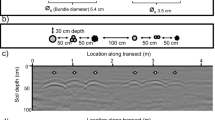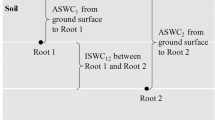Abstract
Background and aims
The diverse functions of roots set requirements on specific root system architecture (RSA). Investigation on RSA holds potentials for studying the adaptation of plants to environmental stresses and to interspecific competitions. Ground-penetrating radar (GPR) has provided a non-invasive method for studying in situ RSA. However, previous GPR method relied on manually connecting root points detected between radargrams to restore each root branch, resulting in limited accuracy and efficiency of reconstructing RSA. The objective of this study is to improve the effectiveness of 3D RSA reconstruction using GPR root detection data.
Methods
A total of 213 coarse root sections (with diameter >0.5 cm) were extracted from a distribution map of a reference shrub (Arctostaphylos pungens) root system to simulate the coarse roots identified by GPR. An automatic method was established to trace each root point to its optimum growing source point. Connections between discrete root points recovered the topology of the reference RSA. A spline curve smoothing method was applied to restore the 3D morphology of the reference RSA. The proposed protocol was then tested to rebuild the 3D RSA of a shrub (Caragana microphylla) growing in the sandy soils after in situ GPR survey. The accuracy of RSA reconstruction was quantitatively evaluated by a relationship matrix method and qualitatively assessed by direct comparisons between the reconstructed and the actual RSAs after in situ excavation.
Results
For both simulated and field collected GPR detection datasets, the reconstructed RSAs strongly corresponded to the real topology of the actual root systems. When adapting the best strategy, 186 of the 213 (87.32 %) root points on the reference root system of A. pungens were interlinked with correct topology, and the relationship matrix method detected an overall similarity of 82.75 % between the reconstructed and the actual RSAs.
Conclusion
The proposed automatic RSA reconstruction method greatly enhances the interpretation of GPR detection data regarding coarse roots, making in situ non-invasive and long-term mapping and monitoring of RSA possible.











Similar content being viewed by others
Abbreviations
- 3D:
-
Three-dimension
- GPR:
-
Ground-penetrating radar
- GSP:
-
Growing source point
- RSA:
-
Root system architecture
References
Al-Ghazi Y, Muller B, Pinloche S, Tranbarger TJ, Nacry P, Rossignol M, Tardieu F, Doumas P (2003) Temporal responses of Arabidopsis root architecture to phosphate starvation: evidence for the involvement of auxin signalling. Plant Cell Environ 26:1053–1066. doi:10.1046/j.1365-3040.2003.01030.x
Bartels RH, Beatty JC, Barsky BA (1987) An introduction of splines for use in computer graphics and geometric modeling. Morgan Kaufmann Publishers, Los Altos
Brown TN, Kulasiri D (1994) Simulation of Pinus radiata root system structure for ecosystem management applications. Simulation 62:286–294. doi:10.1177/003754979406200502
Butnor JR, Doolittle JA, Kress L, Cohen S, Johnsen KH (2001) Use of ground-penetrating radar to study tree roots in the southeastern United States. Tree Physiol 21:1269–1278. doi:10.1093/treephys/21.17.1269
Butnor JR, Doolittle JA, Johnsen KH, Samuelson L, Stokes T, Kress L (2003) Utility of ground-penetrating radar as a root biomass survey tool in forest systems. Soil Sci Soc Am J 67:1607–1615. doi:10.2136/sssaj2003.1607
Cahill JF, McNickle GG, Haag JJ, Lamb EG, Nyanumba SM, Clair CCS (2010) Plants intergrate information about nutrients and neighbors. Science 328:1657–1657. doi:10.1126/science.1189736
Cermák J, Hruka J, Martinková M, Prax A (2000) Urban tree root systems and their survival near houses analyzed using ground penetrating radar and sap flow techniques. Plant Soil 219:103–116. doi:10.1023/a:1004736310417
Cui X, Chen J, Shen J, Cao X, Chen X, Zhu X (2011) Modeling tree root diameter and biomass by ground-penetrating radar. Sci China Earth Sci 54:711–719. doi:10.1007/s11430-010-4103-z
Cui X, Guo L, Chen J, Chen X, Zhu X (2013) Estimating tree-root biomass in different depths by ground-penetrating radar: evidences from a controlled experiment. IEEE TGRS 51:3410–3423. doi:10.1109/TGRS.2012.2224351
Danjon F, Reubens B (2008) Assessing and analyzing 3D architecture of woody root systems, a review of methods and applications in tree and soil stability, resource acquisition and allocation. Plant Soil 303:1–34. doi:10.1007/s11104-007-9470-7
Fitter AH, Stickland TR, Harvey ML, Wilson GW (1991) Architectural analysis of plant-root systems. 2. Influence of nutrient supply, on architecture in contrasting plant-species. New Phytol 118:383–389. doi:10.1111/j.1469-8137.1991.tb00019.x
Ge Z, Rubio G, Lynch JP (2000) The importance of root gravitropism for inter-root competition and phosphorus acquisition effciency: results from a geometric simulaiton model. Plant Soil 218:159–171
Godin C (2000) Representing and encoding plant architecture: A review. Ann For Sci 57:413–438
Gregory PJ (2006) Plant roots: growth, activity and interactions with the soil. Blackwell Science, Oxford
Guo L, Chen J, Cui X, Fan B, Lin H (2013a) Application of ground penetrating radar for coarse root detection and quantification: a review. Plant Soil 362:1–23. doi:10.1007/s11104-012-1455-5
Guo L, Lin H, Fan B, Cui X, Chen J (2013b) Impact of root water content on root biomass estimation using ground penetrating radar: evidence from forward simulations and field controlled experiments. Plant Soil 371:503–520. doi:10.1007/s11104-013-1710-4
Guo L, Lin H, Fan B, Cui X, Chen J (2013c) Forward simulation of root's ground penetrating radar signal: simulator development and validation. Plant Soil 372:487–505. doi:10.1007/s11104-013-1710-4
Hirano Y, Dannoura M, Aono K, Igarashi T, Ishii M, Yamase K, Makita N, Kanazawa Y (2009) Limiting factors in the detection of tree roots using ground-penetrating radar. Plant Soil 319:15–24. doi:10.1007/s11104-008-9845-4
Hruska J, Cermák J, Šustek S (1999) Mapping tree root systems with ground-penetrating radar. Tree Physiol 19:125–130. doi:10.1093/treephys/19.2.125
Isaac ME, Anglaaere LC (2013) An in situ approach to detect tree root ecology: linking ground-penetrating radar imaging to isope-derived eater acquisition zones. Ecol Evol 3:1330–1339. doi:10.1002/ece3.543
Isaac ME, Anglaaere LCN, Borden K, Adu-Bredu S (2014) Intraspecific root plasticity in agroforestry systems across edaphic conditions. Agr Ecosyst Environ 185:16–23
Iyer-Pascuzzi AS, Symonova O, Mileyko Y, Hao Y, Belcher H, Harer J, Weitz JS, Benfey PN (2010) Imaging and analysis platform for automatic phenotyping and trait ranking of plant root systems. Plant Physiol 152:1148–1157. doi:10.1104/pp. 109.150748
Kummerow J, Krause D, Jow W (1977) Root systems of chaparral shrubs. Oecologia 29:163–177. doi:10.1007/bf00345795
Lambers H, Shane MW, Cramer MD, Pearse SJ, Veneklaas EJ (2006) Root structure and functioning for efficient acquisition of phosphorus: matching morphological and physiological traits. Ann Bot 98:693–713. doi:10.1093/aob/mcl114
Lynch J (1995) Root Architecture and Plant Productivity. Plant Physiol 109:7–13
Miller D (1986) Root systems in relation to stress tolerance. Hort Sci 21:963–970
Pagès L, Asseng S, Pellerin S, Diggle A (2000) Modelling root system growth and architecture. In: Smit A, Bengough AG, Engels C, Noordwijk M, Pellerin S, Geijn S (eds) Root Methods. Springer, Berlin
Persson HA, Waisel Y, Eshel A, Kafkafi U (2002) Root systems of arboreal plants. In: Weisel Y, Eshel A, Kafkafi U (eds) Plant roots, the hidden half, 3rd edn. Marcel Dekker, New York, pp 287–313
Reubens B, Poesen J, Danjon F, Geudens G, Muys B (2007) The role of fine and coarse roots in shallow slope stability and soil erosion control with a focus on root system architecture: a review. Trees 21:385–402. doi:10.1007/s00468-007-0132-4
Skaggs TH, Shouse PJ (2008) Roots and Root Function: Introduction. Vadose Zone J 7:1008–1009. doi:10.2136/vzj2008.0076
Stokes A, Fourcaud T, Hruska J, Cermák J, Nadyezdhina N, Nadyezhdin V, Praus L (2002) An evaluation of different methods to investigate root system architecture of urban trees in situ: I. Ground-penetrating radar. J Arboricult 28:2–10
Stover DB, Day FP, Butnor JR, Drake BG (2007) Effect of elevated CO2 on coarse-root biomass in Florida scrub detected by ground-penetrating radar. Ecology 88:1328–1334. doi:10.1890/06-0989
Tanikawa T, Hirano Y, Dannoura M, Yamase K, Aono K, Ishii M, Igarashi T, Ikeno H, Kanazawa Y (2013) Root orientation can affect detection accuracy of ground-penetrating radar. Plant Soil 373:317–327. doi:10.1007/s11104-013-1798-6
Van der Heijden G, De Visser P, Heuvelink E (2007) Measurements for functional-structural plant models. Frontis 22:13–25
Wu Y, Guo L, Li W, Cui X, Chen J (2014) Comment on: “root orientation can affect detection accuracy of ground-penetrating radar”. Plant Soil. doi:10.1007/s11104-014-2124-7
Zenone T, Morelli G, Teobaldelli M, Fischanger F, Matteucci M, Sordini M, Armani A, Ferrè C, Chiti T, Seufert G (2008) Preliminary use of ground-penetrating radar and electrical resistivity tomography to study tree roots in pine forests and poplar plantations. Funct Plant Biol 35:1047–1058. doi:10.1071/FP08062
Acknowledgements
This study was supported by the National Natural Science Foundation of China (Grant No. 41001239), Fundamental Research Funds for the Central Universities by Beijing Normal University (Grant No. 2013NT39), and the State Key Laboratory of Earth Surface Processes and Resource Ecology. The authors also thank three anonymous reviewers for their detailed and valuable comments.
Author information
Authors and Affiliations
Corresponding author
Additional information
Responsible Editor: Peter J. Gregory.
Yuan Wu and Li Guo Contributed equally to this work
Electronic supplementary material
Below is the link to the electronic supplementary material.
video S1
3D model of the reconstructed RSA for the simulated root system (A. pungens). 3D animation was created with a graphic software, AutoCAD (Autodesk Inc., U.S.A.). (MPG 6367 kb)
video S2
3D model of the reconstructed RSA for the field studied root system (C. microphylla). 3D animation was created with a graphic software, AutoCAD (Autodesk Inc., U.S.A.). (MPG 6199 kb)
Rights and permissions
About this article
Cite this article
Wu, Y., Guo, L., Cui, X. et al. Ground-penetrating radar-based automatic reconstruction of three-dimensional coarse root system architecture. Plant Soil 383, 155–172 (2014). https://doi.org/10.1007/s11104-014-2139-0
Received:
Accepted:
Published:
Issue Date:
DOI: https://doi.org/10.1007/s11104-014-2139-0




